PDF 인쇄 - Rotary International
PDF 인쇄 - Rotary International
PDF 인쇄 - Rotary International
Create successful ePaper yourself
Turn your PDF publications into a flip-book with our unique Google optimized e-Paper software.
ANNUAL REPORT 2011-12<br />
ROTARY INTERNATIONAL<br />
THE ROTARY FOUNDATION<br />
i
Photo by Alyce Henson<br />
Rotarians and friends in Munich, Germany, raise<br />
funds for polio eradication and awareness of the<br />
disease through a 250-mile bike ride.
ROTARY INTERNATIONAL AND<br />
THE ROTARY FOUNDATION<br />
Annual Report 2011-12
MESSAGE FROM<br />
THE PRESIDENT AND TRUSTEE CHAIR<br />
PHOTO BY ALYCE HENSON<br />
2
A year of major accomplishments<br />
The 2011-12 <strong>Rotary</strong> year was a time of striving for change in the context of <strong>Rotary</strong><br />
continuity. We challenged ourselves to Reach Within to Embrace Humanity — while<br />
Doing Good in the World. In this annual report, you will see just a few examples of<br />
the ways in which 1.2 million Rotarians worldwide worked to improve the lives of<br />
people in need.<br />
Tremendous strides were made toward the eradication of polio. We made history on<br />
13 January, when India marked one full year without a single new case of the disease.<br />
Long considered the toughest nut to crack, India has now been removed from the list<br />
of polio-endemic countries — leaving just Afghanistan, Nigeria, and Pakistan.<br />
Also in January, we were able to announce that <strong>Rotary</strong>’s US$200 Million Challenge<br />
had been surpassed, six months ahead of schedule. On 30 June, the Challenge closed,<br />
having raised over $228 million for polio eradication, thanks to the generosity of<br />
Rotarians and friends of <strong>Rotary</strong> around the world. We are confident that <strong>Rotary</strong><br />
will continue to lead the way toward the momentous achievement of global polio<br />
eradication.<br />
During 2011-12 we also looked to the future, through our new Future Vision<br />
grant model and the RI strategic plan. We expanded <strong>Rotary</strong>’s reach in new and<br />
effective ways by entering into partnerships with Mercy Ships, UNESCO-IHE,<br />
ShelterBox, the Global FoodBanking Network, and Youth Service America. And we<br />
built on our record of humanitarian service by continuing our strong relationships<br />
with the Global Polio Eradication Initiative spearheading partners (the World<br />
Health Organization, the U.S. Centers for Disease Control and Prevention, and<br />
UNICEF) and the Bill & Melinda Gates Foundation; USAID; Aga Khan University;<br />
Oikocredit; Goodwill Industries <strong>International</strong>; Dolly Parton’s Imagination Library;<br />
the <strong>International</strong> Reading Association; and the <strong>Rotary</strong> Peace Centers.<br />
As we move forward into a new <strong>Rotary</strong> year of building Peace Through Service, we<br />
can be proud of all that Rotarians have accomplished — day by day, week by week,<br />
throughout the world, together.<br />
Kalyan Banerjee<br />
2011-12 President<br />
<strong>Rotary</strong> <strong>International</strong><br />
William B. Boyd<br />
2011-12 Trustee Chair<br />
The <strong>Rotary</strong> Foundation<br />
All figures in U.S. dollars throughout this report.<br />
3
<strong>Rotary</strong> on the World Stage<br />
PHOTO BY MONIKA LOZINSKA<br />
Champions of Change at the White House<br />
Ten U.S. Rotarians were honored as Champions of Change at the White House on 20 April<br />
for their exemplary local and international humanitarian work. At the daylong event in<br />
Washington, D.C., more than 160 Rotarians attended briefings by U.S. government officials<br />
on topics including maternal and child health, disease prevention, economic development,<br />
youth and education, water and sanitation, and peace-building.<br />
4
Presidential meeting<br />
RI President Kalyan Banerjee presents<br />
Afghan President Hamid Karzai with<br />
a medal in recognition of Karzai’s<br />
support for polio eradication. Banerjee<br />
is the first RI president to visit<br />
Afghanistan. During their 45-minute<br />
meeting, the two discussed how<br />
lessons learned from India’s success<br />
might be applied in Afghanistan.<br />
PHOTO BY MCPL DANY VIELLETTE, RIDEAU HALL<br />
A royal invitation<br />
Rotaractor Andrea Tirone and Interactor Kiara Vallier were among 120 young adults who<br />
met with Prince William and Kate Middleton, the Duke and Duchess of Cambridge, in<br />
Ottawa, Canada. They were invited to meet the royal couple because of their dedication<br />
to humanitarian service.<br />
5
2011-12 Membership<br />
PHOTO BY ALYCE HENSON<br />
6<br />
532 ROTARY DISTRICTS<br />
34,533 ROTARY CLUBS<br />
1,227,189 ROTARIANS<br />
171,120 RCC PARTICIPANTS<br />
7,440 ROTARY COMMUNITY CORPS<br />
Rotarian Ayako “Aya” Taguchi of the <strong>Rotary</strong> Club of<br />
Morioka North, Japan, is one of many Rotarians who<br />
helped local communities in the wake of the 2011<br />
tsunami. Here, she addresses schoolchildren in Otsuchi.<br />
<strong>Rotary</strong> club members are men<br />
and women of all ages and<br />
professional backgrounds who use<br />
their talents, skills, and energy<br />
to improve the lives of people<br />
in communities at home and<br />
around the world. The 1.2 million<br />
men and women of <strong>Rotary</strong> also<br />
connect with other professionals<br />
and share their experience with<br />
youth and young professionals.<br />
Through the <strong>Rotary</strong> Community<br />
Corps, non-Rotarian volunteers<br />
get involved in service projects.
Rotarians by region of the world<br />
North America and the Caribbean<br />
379,425<br />
Central and South America<br />
101,365<br />
Europe<br />
323,817<br />
Africa and<br />
Southwest Asia<br />
35,511<br />
South and Southeast Asia<br />
(including India)<br />
172,006<br />
North Asia<br />
(including Japan and Korea)<br />
151,670<br />
Austrailia, Philippines,<br />
and Pacific Realm<br />
63,395<br />
7
New Generations<br />
Each year, <strong>Rotary</strong> connects thousands of young people to a global<br />
network of friendship, service, and action. As Rotaractors and<br />
Interactors, they make a difference in communities at home and<br />
abroad. Through <strong>Rotary</strong> Youth Exchange, they explore new cultures.<br />
<strong>Rotary</strong> Youth Leadership Awards participants learn skills that will<br />
help them succeed as future community leaders.<br />
Each year, 500,000 young people<br />
participate in NEW GENERATIONS programs<br />
ROTARACT<br />
9,388 clubs<br />
215,924 Rotaractors (ages 18-30)<br />
INTERACT<br />
14,734 clubs<br />
338,836 Interactors (ages 12-18)<br />
ROTARY YOUTH EXCHANGE<br />
8,000 students from 80 countries (ages 14-19)<br />
PHOTO BY ALYCE HENSON<br />
ROTARY YOUTH LEADERSHIP AWARDS<br />
25,000 students and young adults<br />
8
Andrea Tirone from the Rotaract Club of the<br />
University of Toronto, Canada, helps repaint a<br />
flood-damaged school during a preconvention<br />
service project near Bangkok, Thailand.<br />
9
The <strong>Rotary</strong> Advantage<br />
Photo by Alyce Henson<br />
10
Rotarians have the determination, the<br />
experience, and that professional know-how to<br />
take on some of the world’s biggest challenges<br />
in some of the world’s most remote areas.<br />
In Kasamu-Kyali parish, Uganda, local<br />
Rotarians from the Muyenga club partnered<br />
with Rotarians in Belgium on a multiyear<br />
Foundation grant project that addresses needs<br />
in three of <strong>Rotary</strong>’s areas of focus: water and<br />
sanitation, disease prevention and treatment,<br />
and economic and community development.<br />
It has established a clean water system, a bakery,<br />
a goat-breeding program, a vocational center<br />
where women sew dresses and uniforms for<br />
orphans and free mosquito bed nets for the<br />
community, and a solar-powered cold-chain<br />
facility that stores vaccines.<br />
In 2012, members of a visiting <strong>Rotary</strong><br />
vocational training team shared their expertise<br />
by assisting the treatment of patients at a health<br />
clinic sponsored by the Muyenga club. “This was<br />
a revelation — to see a single project touching<br />
so many areas of the lives of the inhabitants,”<br />
said Past District Governor Matthias Oladeinde<br />
Shoga, who led the team.<br />
<strong>Rotary</strong>’s unique approach enables professionals<br />
traveling abroad to learn more about their<br />
vocation and/or to teach local professionals<br />
about it. This team, which visited the Aga<br />
Khan University campus in Kampala, Uganda,<br />
included three nurse educators from Nigeria<br />
who trained their counterparts in teaching<br />
practices that promote student learning and<br />
improve effectiveness in education.<br />
11
ERADICATING POLIO<br />
India is no longer polio endemic,<br />
but immunization against the<br />
disease must continue in all<br />
countries until the eradication of<br />
polio is certified worldwide.<br />
A Rotarian from District 3700 (Korea) administers<br />
oral polio vaccine to a child at a health camp in<br />
Meerut, Uttar Pradesh, India, in November.<br />
12
Key milestones met:<br />
India no longer polio endemic<br />
<strong>Rotary</strong> has played a key role in the<br />
significant progress made by the Global<br />
Polio Eradication Initiative (GPEI),<br />
underscored in February when the World<br />
Health Organization (WHO) removed<br />
India from the list of polio-endemic<br />
countries. Only three countries remain:<br />
Afghanistan, Nigeria, and Pakistan.<br />
“With the support of their <strong>Rotary</strong> brothers<br />
and sisters around the world, Indian<br />
Rotarians have worked diligently month<br />
after month, year after year, to help organize<br />
and carry out the National Immunization<br />
Days that reach millions of children with<br />
the oral polio vaccine,” says RI President<br />
Kalyan Banerjee.<br />
“India is tantalizingly close to eradicating<br />
polio. <strong>Rotary</strong> <strong>International</strong> has committed<br />
to be the torchbearer until India and<br />
the world become polio free,” says Past<br />
RI President Rajendra K. Saboo. Polio<br />
eradication is certified on a regional basis;<br />
certification occurs when all countries in<br />
a region demonstrate the absence of wild<br />
poliovirus transmission for at least three<br />
consecutive years.<br />
A Rotarian from the United States shares a<br />
moment with a child at a rally promoting polio<br />
eradication in Bhavanagar, Gujarat, India.<br />
Families in Delhi, India, bring their children to<br />
be vaccinated against polio during a National<br />
Immunization Day.<br />
Rotarians meet the challenge<br />
Rotarians around the world exceeded<br />
<strong>Rotary</strong>’s US$200 Million Challenge,<br />
<strong>Rotary</strong>’s response to $355 million in<br />
matching grants awarded by the Bill &<br />
Melinda Gates Foundation to The <strong>Rotary</strong><br />
Foundation for polio eradication efforts.<br />
As of 30 June, Rotarians had raised over<br />
$228 million.<br />
“In recognition of <strong>Rotary</strong>’s great work,<br />
and to inspire Rotarians in the future,<br />
the [Gates] foundation is committing<br />
an additional $50 million to extend our<br />
partnership,” said Jeff Raikes, chief executive<br />
officer of the Gates Foundation, speaking at<br />
<strong>Rotary</strong>’s <strong>International</strong> Assembly in January.<br />
“<strong>Rotary</strong> started the global fight against<br />
polio, and continues to set the tone for<br />
private fundraising, grassroots engagement,<br />
and maintaining polio at the top of the<br />
agenda with key policymakers,” Raikes said.<br />
The <strong>Rotary</strong> Foundation is distributing funds<br />
from the $50 million Gates Foundation<br />
grant, which is not a challenge grant, to<br />
the most critical polio-affected countries,<br />
primarily through grants to the World<br />
Health Organization and UNICEF in direct<br />
support of polio immunization activities.<br />
PHOTO BY NICKI SCOTT<br />
13
ERADICATING POLIO<br />
Emergency Action Plan launched<br />
Despite the dramatic drop in polio cases<br />
worldwide, especially in nonendemic<br />
countries, the threat of continued transmission<br />
due to funding and immunization gaps<br />
prompted the launch of the Global Polio<br />
Emergency Action Plan 2012-13.<br />
The plan builds on India’s success and aims<br />
to boost immunization coverage to make<br />
the remaining polio-endemic countries<br />
polio free. In support of the plan, WHO<br />
adopted a resolution in May that declared<br />
“the completion of polio eradication to be a<br />
programmatic emergency for global public<br />
health.”<br />
Likewise, The <strong>Rotary</strong> Foundation Board of<br />
Trustees reaffirmed that polio eradication is<br />
the urgent priority of the Foundation and that<br />
continued support for PolioPlus is essential.<br />
Advocacy stepped up<br />
<strong>Rotary</strong> and its global partners in the GPEI —<br />
the World Health Organization, UNICEF, U.S.<br />
Centers for Disease Control and Prevention<br />
(CDC) — and the Bill & Melinda Gates<br />
Foundation are emphasizing the importance<br />
of advocating for national governments to<br />
fully fund the worldwide effort.<br />
A petition drive carried out by Australian<br />
Rotarians and the Global Poverty Project,<br />
and the project’s End of Polio Concert in<br />
October, encouraged government leaders<br />
to put polio eradication on the agenda of<br />
the Commonwealth Heads of Government<br />
Meeting in Perth. Following the meeting,<br />
the governments of Australia, Canada, and<br />
Nigeria, along with the Gates Foundation,<br />
announced a combined pledge of more than<br />
$100 million to support polio eradication<br />
efforts. Canadian Rotarians also played a<br />
pivotal role in encouraging their government’s<br />
support for the cause.<br />
“<strong>Rotary</strong> leaders continue to meet with the<br />
heads of state of key donor and polio-affected<br />
countries to ensure that polio eradication<br />
remains a top priority in every nation and that<br />
funding commitments to the program are<br />
met,” says Robert S. Scott, chair of <strong>Rotary</strong>’s<br />
<strong>International</strong> PolioPlus Committee.<br />
Filmmaker Zorro Gamarnik, Robert Pennicott,<br />
of the <strong>Rotary</strong> Club of Kingston, Tasmania,<br />
Australia, and Mick Souter celebrate after<br />
completing the first-ever circumnavigation<br />
of Australia in boats powered by outboard<br />
motors. They raised $250,000 for <strong>Rotary</strong>’s<br />
US$200 Million Challenge for polio eradication.<br />
<strong>Rotary</strong> on the<br />
World Stage<br />
RI President-elect Sakuji Tanaka<br />
hears reassuring words from Prime<br />
Minister Yoshihiko Noda regarding Japan’s<br />
continued support of polio eradication,<br />
<strong>Rotary</strong>’s top priority.<br />
PHOTO BY NORIKO FUTAGAMI<br />
14
Stopping the poliovirus in India<br />
The All India End Polio Now Road Show,<br />
organized by District 3201 (parts of Kerala<br />
and Tamil Nadu), increased awareness of<br />
the disease in India, Nepal, and Bhutan.<br />
Starting in Kochi, Kerala, on 11 December,<br />
a team of six Rotarians visited towns<br />
and villages in 24 states, meeting with<br />
government health officials along the way.<br />
Their journey covered an estimated 11,500<br />
miles before ending in Coimbatore, Tamil<br />
Nadu, on 14 February.<br />
Polio cases worldwide<br />
1985 2012<br />
350,000 cases<br />
125 countries<br />
➡<br />
water and sanitation || disease prevention and treatment<br />
An estimated two million people die<br />
every year from waterborne diseases,<br />
and more than one billion lack access<br />
to clean water.<br />
Residents of Makoor, Kerala, India, show the<br />
effects of years of drinking and cooking with<br />
highly fluoridated water.<br />
PHOTO BY Allison Kwesell<br />
16
Clean water brings better health<br />
The residents of Patari, a village in Uttar<br />
Pradesh, are among 25 million people<br />
in India who suffer the consequences of<br />
fluorosis, an irreversible condition caused by<br />
elevated levels of fluoride in drinking water.<br />
The painful effects of fluorosis can include<br />
bone deformities, calcification of ligaments<br />
and tendons, and osteosclerosis (abnormal<br />
bone density). Dental effects include<br />
mottling and erosion of tooth enamel.<br />
“The fluoride, because of its strength, rots<br />
teeth and destroys bones,” says Maurice<br />
Halliday, past governor of District 1020<br />
(Scotland), which worked with District<br />
3110 (parts of Madhya Pradesh and Uttar<br />
Pradesh, India) to provide fluoride filters<br />
to 60 families in Patari through a <strong>Rotary</strong><br />
Foundation grant-funded project.<br />
The $40,000 project also provided toilets,<br />
safe drinking water, and hygiene training to<br />
eight schools serving about 2,300 students<br />
in Uttar Pradesh. WHO estimates that<br />
almost one-tenth of global disease could be<br />
prevented by improving the water supply,<br />
sanitation, hygiene, and the management<br />
of water resources. As the Indian villages<br />
demonstrate, the solution requires a targeted<br />
approach, including assessments of each<br />
community’s needs.<br />
PHOTO BY ALLISON KWESELL<br />
<strong>Rotary</strong> on the World Stage<br />
Ghulam Nabi Azad (far right), India’s<br />
minister of health and family welfare, visits<br />
<strong>Rotary</strong> World Headquarters in Evanston,<br />
Illinois, USA, to discuss India’s progress<br />
toward polio eradication with <strong>Rotary</strong><br />
leaders and staff, including <strong>International</strong><br />
PolioPlus Committee Chair Robert S. Scott,<br />
RI President Kalyan Banerjee, and <strong>Rotary</strong><br />
Foundation Trustee Chair William Boyd.<br />
“My country has benefited greatly from your<br />
support, and I thank all of you,” Azad says.<br />
PHOTO BY ALYCE HENSON<br />
VOICES<br />
OF ROTARY<br />
“People throughout the village come to the well with their<br />
buckets and cups in hand. Everyone is silent as one of the<br />
elders starts pumping the handle. Cheers erupt when the<br />
water comes forth. Seeing the smiling faces of the men,<br />
women, and children makes all of the challenges worth it.”<br />
Walter Hughes, member of the <strong>Rotary</strong> Club of Rocky Mount, Virginia,<br />
USA, and participant in an 80-club effort that is bringing clean water<br />
to villagers in Ghana.<br />
17
DISEASE PREVENTION AND TREATMENT || MATERNAL AND CHILD HEALTH<br />
About 29,000 children under the age of five – 21 each<br />
minute – die every day, mainly from preventable causes.<br />
The Ukrainian Children’s Cardiac Center, created<br />
by Rotarians from Ukraine, Australia, Canada,<br />
and the United States, provides surgery to<br />
children with congenital heart disease.<br />
PHOTO BY ALYCE HENSON<br />
18
Boosting a child’s chances<br />
A maternal and child health complex is<br />
saving children’s lives near Dar es Salaam,<br />
Tanzania. Inspired by 2008-09 RI President<br />
Dong Kurn Lee’s emphasis on reducing<br />
child mortality, Rotarians in Korea and<br />
Tanzania worked together to establish the<br />
55-bed facility, which opened at Tumbi<br />
Hospital in 2011. It includes a fully<br />
equipped surgical center, delivery rooms,<br />
and an X-ray room.<br />
The hospital serves an area of more than one<br />
million people. Before the project began,<br />
the facility did not have a well-equipped<br />
maternity wing and mothers typically gave<br />
birth to their babies on dirty beds.<br />
The project received funding from several<br />
sources, including about $500,000<br />
from Korean Rotarians, $150,000 from<br />
Japanese Rotarians, two <strong>Rotary</strong> Foundation<br />
grants totaling $190,000, and matching<br />
contributions from the Community<br />
Chest of Korea and Korea <strong>International</strong><br />
Cooperation Agency. Tanzanian Rotarians,<br />
led by Past <strong>Rotary</strong> Foundation Trustee<br />
Jayantilal Chande and Bill Bali, of the<br />
<strong>Rotary</strong> Club of Dar-es-Salaam North,<br />
monitored the project.<br />
In May, the project provided two ambulances<br />
to augment the hospital’s services.<br />
Rotarians from Korea greet a mother and her<br />
child at the maternal and child health complex<br />
near Dar es Salaam, Tanzania. Korean <strong>Rotary</strong><br />
clubs helped raise more than $2 million for<br />
the project from several sources. Past RI<br />
President Dong Kurn Lee (far right) inspired<br />
the effort.<br />
<strong>Rotary</strong> on the World Stage<br />
Bill Gates, cochair of the Bill & Melinda<br />
Gates Foundation, joins dozens of<br />
Rotarians on Capitol Hill in Washington,<br />
D.C., on World Polio Day, 24 October, to<br />
affirm the joint commitment of the Gates<br />
Foundation and <strong>Rotary</strong> to eradicate the<br />
disease. <strong>Rotary</strong>’s work as a spearheading<br />
partner of the Global Polio Eradication<br />
Initiative is creating a model for tackling<br />
other global health problems, such as<br />
malaria, measles, and lack of clean water.<br />
PHOTO BY ALLISON O’BRIEN<br />
VOICES<br />
OF ROTARY<br />
“Our job is to accompany the local doctors and teach other<br />
physicians and nurses how to improve the quality of care<br />
they provide and, hopefully, have some sustainable impact.”<br />
Dr. Alexandra Vinograd, pediatric specialist at a hospital in Butaro,<br />
Rwanda, that serves 400,000 people. Vinograd, an American, was a<br />
2000-01 <strong>Rotary</strong> Ambassadorial Scholar in Peru and a <strong>Rotary</strong> Youth<br />
Exchange student in Germany.<br />
19
ECONOMIC AND COMMUNITY DEVELOPMENT || BASIC EDUCATION AND LITERACY<br />
Literacy and poverty are<br />
closely connected, and at<br />
least 1.2 billion poor people<br />
cannot read or write.<br />
Members of the <strong>Rotary</strong> Club of Cayes, Haiti, made possible<br />
a new computer lab at Lycee Philippe Guerrier, a local<br />
secondary school. After the 2010 earthquake killed<br />
220,000 people and devastated Haiti’s infrastructure,<br />
Rotarians from more than 20 countries contributed over<br />
$2 million to the Haiti Earthquake Relief Fund set up by<br />
The <strong>Rotary</strong> Foundation.<br />
PHOTO BY ALYCE HENSON<br />
20
Investing in people<br />
Nijad K. Al Atassi, past governor of District<br />
2450 (parts of Africa, the Middle East,<br />
Cyprus, and Georgia) feels so strongly about<br />
vocational service, he made it a districtwide<br />
priority.<br />
“Vocational service is important because it<br />
enhances values and faith in ethics,” says<br />
Al Atassi, a member of the <strong>Rotary</strong> Club of<br />
Adliya, Bahrain.<br />
The <strong>Rotary</strong> Club of Alexandria Sporting,<br />
Egypt, rose to the challenge by focusing<br />
on microcredit loans, literacy classes,<br />
and a sewing workshop for low-income<br />
community members, especially women,<br />
to start businesses and learn work skills.<br />
Club members made loans of about $85<br />
each to 20 entrepreneurs to launch small<br />
food or cleaning businesses. The loans<br />
were paid back in installments over the<br />
course of a year, and the money was then<br />
loaned out again — turning the club’s<br />
initial investment of about $1,700 into a<br />
sustainable microcredit program.<br />
Solar panels bring light to school<br />
The head teacher of Canumay National<br />
High School in Valenzuela City, Philippines<br />
(below), used to hit a makeshift gong with<br />
a rock to mark the start and end of classes.<br />
Now, because of a <strong>Rotary</strong> Foundation<br />
grant-supported project, 10 solar panels are<br />
providing electricity, and classes begin at<br />
the sound of a buzzer. Mark Kendziorek, a<br />
member of the <strong>Rotary</strong> Club of South Everett/<br />
Mukilteo, Washington, USA, who took this<br />
photo, helped write the grant proposal, in<br />
partnership with the <strong>Rotary</strong> Club of Rizal<br />
Centro, Philippines.<br />
Before the panels<br />
were installed,<br />
students had to<br />
study by the light<br />
of kerosene lamps.<br />
This image of the last<br />
time the gong was<br />
sounded, Kendziorek<br />
says, represents<br />
“a transition from<br />
the old to the new.”<br />
PHOTO BY MARK KENDZIOREK<br />
<strong>Rotary</strong> on the<br />
World Stage<br />
Michel P. Jazzar, RI representative to the<br />
United Nations Economic and Social Commission<br />
for Western Asia, and Richard S. Carson, RI<br />
representative to the Organization of American<br />
States, confer between panel presentations<br />
during <strong>Rotary</strong>-UN Day in New York City.<br />
PHOTO BY ALYCE HENSON<br />
VOICES<br />
OF ROTARY<br />
PHOTO BY TONY GIBSON<br />
“If you can establish a modern, sustainable distribution<br />
and supply chain between small farmers and various food<br />
markets, governments will be more inclined to improve<br />
roads, power, and infrastructure.”<br />
Australian Alex Dalley, Global Grant <strong>Rotary</strong> Scholar, MBA candidate at<br />
the Rotterdam School of Management in the Netherlands, and former<br />
adviser on private-sector development programs in the Democratic<br />
Republic of Timor-Leste.<br />
21
PEACE AND CONFLICT PREVENTION/RESOLUTION<br />
It’s estimated that more than 1 billion children under the<br />
age of 18 live in areas affected by conflict.<br />
Ou Phana and her husband, Peach Saveum,<br />
were injured in land mine explosions in<br />
Cambodia, one of the most land mine-affected<br />
countries in the world. The Kien Khleang<br />
Rehabilitation Center, which spurred their<br />
recovery, received funding from the <strong>Rotary</strong><br />
Club of Salisbury, Connecticut, USA, a <strong>Rotary</strong><br />
Foundation grant, and district funds.<br />
PHOTO BY ALYCE HENSON<br />
22
Defender of children<br />
World peace means more than ending wars:<br />
It also means safety for everyone, including<br />
society’s most vulnerable members. Currently,<br />
some 22,000 children are reported missing<br />
worldwide every day, and 5,000 are victims<br />
of commercial sexual exploitation, according<br />
to the <strong>International</strong> Centre for Missing and<br />
Exploited Children in Virginia, USA.<br />
At the agency’s Brazil office, <strong>Rotary</strong> Peace<br />
Fellow alumna Katia de Mello Dantas is<br />
working to stop sexual abuse of children,<br />
including pornography, trafficking, and<br />
abduction. As policy director for Latin<br />
America and the Caribbean, she travels the<br />
region and helps to draft uniform laws and<br />
train law enforcement officers on how to<br />
collect evidence and file charges effectively.<br />
In the past year, she has focused on<br />
protecting children from sexual predators<br />
on the Internet.<br />
Dantas is up to the challenge, thanks in part<br />
to <strong>Rotary</strong>. Her studies at the <strong>Rotary</strong> Peace<br />
Center at Duke University and University<br />
of North Carolina, Chapel Hill, in North<br />
Carolina, USA, were funded by the Paul<br />
F. and Carolyn C. Rizza Endowed <strong>Rotary</strong><br />
Peace Fellowship. As a 2007-09 <strong>Rotary</strong> Peace<br />
Fellow, Dantas completed fieldwork with the<br />
<strong>International</strong> Organization for Migration,<br />
where she researched the impact of crossborder<br />
movement on HIV/AIDS and other<br />
public health issues. She was also a member<br />
of a 2005-06 Group Study Exchange team<br />
from Brazil to the United States.<br />
“Little by little I believe we can get to a<br />
point where all children of the world will<br />
be able to be just that: children. Not toys in<br />
the hands of adults, not mini-workers, not<br />
victims; just children, with their full array of<br />
rights guaranteed,” says Dantas.<br />
<strong>Rotary</strong> Peace Fellow alumna Katia de Mello<br />
Dantas takes part in a panel at a Caribbean<br />
regional meeting on protecting children from<br />
sexual exploitation. In 2011, Dantas was named<br />
one of the Top 99 Under 33 Foreign Policy<br />
Leaders by Young Professionals in Foreign Policy.<br />
<strong>Rotary</strong> on the World Stage<br />
Nobel Peace Prize laureate Leymah Gbowee, of<br />
Liberia, addresses <strong>Rotary</strong> Peace Fellows, Rotarians, and<br />
<strong>Rotary</strong> Foundation alumni at the <strong>Rotary</strong> World Peace<br />
Symposium in Bangkok, Thailand. In 2003, Gbowee<br />
mobilized women across religious and ethnic lines to<br />
bring an end to Liberia’s long and bloody civil war.<br />
PHOTO BY MONIKA LOZINSKA<br />
VOICES<br />
OF ROTARY<br />
PHOTO BY<br />
MONIKA LOZINSKA<br />
“The pedigree of <strong>Rotary</strong> Peace Fellows is strong. <strong>Rotary</strong> can<br />
call on 10 years of <strong>Rotary</strong> Peace Fellows trained to promote<br />
conflict resolution.”<br />
Al Jubitz, member of the <strong>Rotary</strong> Club of Portland, Oregon, USA,<br />
Arch C. Klumph Society member, and <strong>Rotary</strong> Peace Centers supporter.<br />
23
OUR SUPPORTERS<br />
Through generous contributions, <strong>Rotary</strong> funds<br />
sustainable projects that help address the<br />
world’s greatest needs.<br />
<strong>Rotary</strong> Foundation Arch C. Klumph Society<br />
member Rajashree Birla gives an address at<br />
<strong>Rotary</strong>’s 2012 convention in Bangkok, Thailand.<br />
PHOTO BY ALYCE HENSON<br />
24
PHOTO BY JEAN-MARC GIBOUX<br />
Rajashree Birla gives another<br />
$1 million to <strong>Rotary</strong>’s polio<br />
eradication efforts<br />
India’s Rajashree Birla is a staunch supporter<br />
of <strong>Rotary</strong>’s efforts to achieve a polio-free<br />
world. At the 2012 RI Convention in<br />
Bangkok, Thailand, she announced an<br />
additional $1 million contribution to<br />
The <strong>Rotary</strong> Foundation for polio eradication.<br />
Including this gift, her contributions to the<br />
Foundation’s campaign total more than<br />
$6.2 million.<br />
Birla’s late husband, Aditya, made the<br />
Aditya Birla Group into a Fortune 500<br />
company and one of the largest in India.<br />
Her son, Kumar Mangalam, is chairman of<br />
the board, and she serves as a director.<br />
“She is magnanimity, dignity, compassion,<br />
humility, and tranquility personified,” said<br />
RI President Kalyan Banerjee of Birla,<br />
who is an honorary member of the <strong>Rotary</strong><br />
clubs of Bombay and Mulund. “It is not<br />
just the additional $1 million she gave for<br />
polio eradication but the grace and absolute<br />
commitment she reflects that we admire<br />
and respect her for.”<br />
Birla said, “Based on the success of <strong>Rotary</strong><br />
<strong>International</strong>’s initiatives in India —<br />
coupled, of course, with the admirable<br />
backing of the government’s health<br />
departments and institutions like WHO,<br />
UNICEF, CDC, and the Gates Foundation<br />
— the day is not far off for us to envisage<br />
the elimination of polio in the other three<br />
countries where unfortunately its traces<br />
remain. We owe it to ourselves and to<br />
humanity at large to ensure that, in these<br />
three countries as well, polio becomes an<br />
affliction of the past.”<br />
VOICES<br />
OF ROTARY<br />
PHOTO BY ALYCE HENSON<br />
There were 72 new members<br />
inducted into The <strong>Rotary</strong><br />
Foundation’s Arch C. Klumph<br />
Society in 2011-12, with special<br />
ceremonies marking Taiwan Day,<br />
India Day, and Korea Day (left). The<br />
society honors those who give at<br />
least $250,000 to the Foundation.<br />
“The Foundation accepts the<br />
responsibility to use these gifts<br />
to do good in the world.”<br />
William B. Boyd, Foundation Trustee<br />
Chair.<br />
25
OUR SUPPORTERS<br />
Grassroots support makes<br />
The <strong>Rotary</strong> Foundation possible<br />
Over 70 percent of Lima’s drinking water<br />
comes from the Rimac River, which is<br />
polluted with high levels of cadmium,<br />
copper, lead, zinc, and arsenic.<br />
The <strong>Rotary</strong> Foundation and its partners<br />
supplied concrete water filters to 5,000<br />
families living in low-income communities<br />
along the river. Local women train other<br />
families to use the filters. “They are not just<br />
giving us a concrete box. They are giving<br />
us health and a better quality of life for our<br />
children,” said one local beneficiary, noting<br />
that sickness among local children decreased<br />
significantly after the concrete filters were<br />
installed.<br />
The Annual Fund is the primary source<br />
of funding for Foundation activities. The<br />
Annual Fund’s unique three-year investment<br />
cycle gives clubs time to plan high-impact,<br />
sustainable activities and the Foundation time<br />
to invest the contributions. These investment<br />
earnings help cover the Foundation’s<br />
administrative and fundraising expenses.<br />
In Lima, Peru, where nearly 8 million people<br />
lack access to clean drinking water, Rotarians<br />
worked together to improve the water supply<br />
with support from a <strong>Rotary</strong> Foundation grant.<br />
Every Rotarian is encouraged to participate<br />
in a Foundation project and contribute to the<br />
Annual Fund every year. Contributions help<br />
Rotarians carry out a broad range of local and<br />
international projects that do good in the world.<br />
PHOTO BY ALYCE HENSON<br />
<strong>Rotary</strong> on the World Stage<br />
<strong>Rotary</strong>’s ranking In 2012, The <strong>Rotary</strong> Foundation earned a grade of A+ from the<br />
American Institute of Philanthropy, a top rating of four stars from Charity Navigator, and<br />
full accreditation from the Wise Giving Alliance of the Better Business Bureau, based<br />
on the previous year’s results. In fiscal 2012, only 2 percent of Foundation expenditures<br />
went to administrative expenses and 8 percent to fundraising. The Foundation directed<br />
90 percent of its spending to programs, far exceeding the benchmark of 65 percent that<br />
independent charity-rating services view as a measure of high efficiency.<br />
The <strong>Rotary</strong> Foundation funding goes to...<br />
Programs<br />
The Wise Giving Alliance benchmark<br />
Programs<br />
65 %<br />
90 % A +<br />
Fundraising & Administration 10 %<br />
26
10 Top Annual Giving Countries and Geographical Areas<br />
5. CANADA<br />
$7,713 $163<br />
1. UNITED STATES<br />
$73,503* $111<br />
10. BRAZIL<br />
$5,382 $64<br />
7. GERMANY<br />
$6,179 $77<br />
9. UNITED KINGDOM<br />
$5,392 $59<br />
3. INDIA<br />
$14,237 $65<br />
4. KOREA<br />
$10,874 $164<br />
2. JAPAN<br />
$17,783 $129<br />
6. TAIWAN<br />
$6,502 $179<br />
8. AUSTRALIA<br />
$6,022 $115<br />
2011-12 Total Contributions US$ (thousands) (Includes flow-through contributions)<br />
2011-12 Annual Giving per Rotarian US$<br />
* Excludes $10.0 million grant for polio eradication received from the Bill & Melinda Gates Foundation, a U.S. organization.<br />
New inductees of the Arch C. Klumph Society<br />
Albert and Virginia Alley Sudhansu and Mina Bhattacharyya Al and Ruth Braswell Jr. + Patrick W. and Janet R.<br />
Carlton Henry Hsi-Shih Chang and Jolly Li-Yueh Ku Rubber Ying-Chuan Chang and Kiko Pi-Yun Lin Paul Chung-Ho<br />
Chen and Yun-Li Wang Matt Ming-Hung Chen and Susan Hu Computer Chiu-Lin and Jasmine Chiu Byong Seol<br />
Choi and A Jong Lee Deviprasad Gangabux Goenka and Hivdevi Deviprasad Goenka Seung Ryong Han and Hee<br />
Jong You R. Lee and Judith A. Harman James R. and Janice E. Heinrich Lawrence W. and Linda R. Jubie J.B. and<br />
Marlene Kamdar Habil F. and Nafisa Khorakiwala Steven and Iris Laine Angela Ming-Chu Lu Lee and Steve Chen<br />
Tai Lee Dong Kurn Lee and Young Ja Chung May Chin-Mei Lu John H. and A. Rose Moon Sr. Dato’ Ng Kim-Poh<br />
Amko and Lucille Huang Allen D. and Patsy M. Orr Young Koo Park and Eun Hwa Chang Terry N. and Anne P.<br />
Phillips Chuck and Yolanda + Reinhart Frank H. and Judith H. Rothermel Hiroshi and Suma Shimuta Rajju and<br />
Sandra Shroff Surya + and Foram Varsani Hong-Joo Yoon and Kyung Hee Lee Kyun Kim and Hye Suk Jeong Eung<br />
Jong Yoo and Hee Sook Chung In Chul Park and Hai Soon Bae Sang Koo Yun and Eun Sun Yang Yong Keuk Shin<br />
This list includes only those who were inducted into the Arch C. Klumph Society between 1 July 2011 and 30 June 2012.<br />
+ Deceased<br />
New supporters in 2011-12<br />
Major Donors<br />
Benefactors and<br />
Bequest Society<br />
Paul Harris Fellows<br />
Arch C.<br />
Klumph<br />
Society<br />
55<br />
2,199<br />
gifts of<br />
$250,000 or more<br />
2,794<br />
47,218<br />
gifts of<br />
$10,000 or more<br />
estate gifts<br />
gifts of<br />
$1,000 or more<br />
All figures as of 30 June 2012.<br />
27
Our finances<br />
Rotarians and friends of <strong>Rotary</strong> support The <strong>Rotary</strong> Foundation,<br />
which in turn enables Rotarians to do more good in the world.<br />
Photo by Alyce Henson<br />
Selina Konrad works the Marienplatz in Munich,<br />
Germany, to help raise funds for polio eradication.<br />
She is the niece of a local Rotarian.<br />
28
All figures in U.S. dollars throughout this report. 29
ROTARY INTERNATIONAL FINANCIALS<br />
What <strong>Rotary</strong> <strong>International</strong> received<br />
RI received a total of $82.7 million<br />
in revenues for the fiscal year through<br />
membership dues, RI services, and<br />
investments. Revenues were $9.8 million<br />
less than budgeted and $23.2 million less<br />
than the previous year, primarily as a result<br />
of unrealized losses in the market values of<br />
RI’s investments due to continued volatility<br />
in the global financial markets.<br />
Explanation of variances<br />
Dues revenue was $61.4 million, which was<br />
as planned in the budget. RI’s investment<br />
losses were $6.3 million, which was<br />
$12.1 million unfavorable to the budget.<br />
The General Fund portfolio was down<br />
4.0 percent for the fiscal year, driven<br />
principally by unrealized losses. Revenues<br />
from services and other activities were<br />
$27.6 million, which was $2.0 million<br />
greater than budgeted. Compared to fiscal<br />
2011, revenues were lower, mainly due<br />
to a $28.0 million swing in investment<br />
returns. Also, services and other activities<br />
increased by $3.7 million, primarily as a<br />
result of the financial incentive related to<br />
the <strong>International</strong> Convention in Bangkok,<br />
Thailand. Finally, dues revenue increased<br />
by $1.1 million because of a $1 increase in<br />
<strong>Rotary</strong>’s per capita dues.<br />
What <strong>Rotary</strong> <strong>International</strong> spent<br />
RI’s total expenses were $96.3 million,<br />
$0.8 million greater than budgeted and<br />
$16.2 million greater than the previous year.<br />
The operational expenses were spent as<br />
planned in fiscal 2012, including spending<br />
from the General Surplus Fund on strategic<br />
initiatives relating to public relations and<br />
strengthening <strong>Rotary</strong>’s brand. Expenses<br />
from services and other activities were $26.2<br />
million, which was $1.7 million higher than<br />
budgeted. The Bangkok Convention had<br />
33,104 attendees, compared to the budget<br />
for 25,000 registrants. As a result, revenue<br />
and expenses increased proportionately.<br />
Revenues<br />
US$ (millions)<br />
2011 Actual<br />
5.8<br />
Budget 25.6 61.1 92.5<br />
2012<br />
Actual 27.6<br />
61.4<br />
82.7<br />
-6.3<br />
0 50 100<br />
Expenses<br />
US$ (millions)<br />
2011 Actual<br />
Budget<br />
2012<br />
Actual<br />
10.7<br />
Net Investment Return<br />
Services and Other Activities<br />
20.3 59.8<br />
Services and Other Activities<br />
21.7 23.9 60.3<br />
24.5 71.0<br />
26.2<br />
70.1<br />
Operations<br />
Membership Dues<br />
80.1<br />
95.5<br />
96.3<br />
0 50 100<br />
Services and Other Activities<br />
Revenues<br />
US$ (millions)<br />
<strong>International</strong> Convention<br />
U.S. Clubs Insurance<br />
0.9 Publications and Supplies 1.3<br />
3.1<br />
License Fees, Royalties,<br />
and Other Income<br />
Foundation Contribution<br />
and Miscellaneous<br />
0.8<br />
Operations<br />
US$ (millions)<br />
Communications and<br />
Public Relations<br />
Information Services<br />
<strong>International</strong> Offices<br />
Directors, Officers,<br />
and Committees<br />
World Headquarters<br />
Administration<br />
<strong>International</strong> Assembly<br />
Programs and Meetings<br />
Expenses<br />
6.6 Magazine<br />
5.3<br />
5.2<br />
1.1<br />
One <strong>Rotary</strong> Center<br />
1.1<br />
Expenses<br />
3.2<br />
7.1<br />
6.4<br />
5.8<br />
5.3<br />
7.0<br />
10.7<br />
District Governors 9.7<br />
Financial Services 5.4<br />
Member Services 4.2<br />
8.8<br />
14.2<br />
105.9<br />
30<br />
Details of RI’s fiscal 2012 financial information, including the presidents’ and directors’ expenses and audited financial statements, are available at www.rotary.org/annualreport.
Presidents’ expenses<br />
RI paid expenses of $794,000, $473,000,<br />
and $135,000 to and on behalf of the RI<br />
president, president-elect, and president<br />
nominee, respectively. Those included travel<br />
(airfare, hotel, and meals), RI theme, public<br />
relations, housing, and moving costs. RI paid<br />
$583,000 to operate the presidents’ offices.<br />
Assets<br />
US$ (millions)<br />
Total<br />
171.6<br />
Liabilities and Net Assets<br />
US$ (millions)<br />
Total<br />
171.6<br />
46.7<br />
125.3 Cash and Investments<br />
3.5 Club and Other<br />
Accounts<br />
Receivable (net)<br />
36.1 Property and<br />
Equipment (net)<br />
3.0 Due from The <strong>Rotary</strong><br />
Foundation<br />
3.7 Deferred Charges,<br />
Prepaid Expenses,<br />
and Other<br />
Liabilities<br />
5.5 Accounts Payable<br />
20.6 Accrued Expenses<br />
3.6 Deferred Revenue<br />
17.0 Pension Obligation<br />
124.9 Unrestricted Net Assets<br />
Board of Directors’ expenses<br />
RI paid $686,000 on behalf of the Board<br />
of Directors. This amount includes travel to<br />
attend Board meetings, the RI Convention,<br />
and the <strong>International</strong> Assembly, as well<br />
as other travel to clubs, presidential<br />
conferences, and <strong>Rotary</strong> institutes.<br />
<strong>Rotary</strong> <strong>International</strong>’s financial<br />
position<br />
RI’s net assets decreased by $24.1 million as<br />
a result of expenditures exceeding revenues<br />
by $13.6 million and a $10.5 million charge<br />
to record RI’s increased pension obligation<br />
over the previous year.<br />
Recent trends<br />
In fiscal 2003, RI’s expenses exceeded<br />
revenues, primarily due to a difficult<br />
investment climate. From fiscal 2004<br />
through 2007, revenues exceeded expenses<br />
and net assets grew as a result of improved<br />
investment earnings, an increase in<br />
membership dues, and controlled spending.<br />
From fiscal 2008 through 2009, expenses<br />
exceeded revenues, primarily due to a<br />
difficult and volatile investment climate.<br />
From fiscal 2010 through 2011, revenues<br />
exceeded expenses because of improved<br />
investment earnings, stable membership<br />
and dues revenue, and various cost savings<br />
initiatives.<br />
Historical Revenue, Expense, and Net Asset Trends<br />
US$ (millions)<br />
140 _ Unrestricted Net Assets<br />
Revenue<br />
120 _<br />
Expense<br />
100 _<br />
80 _<br />
60 _<br />
40 _<br />
20 _<br />
0 _<br />
2003 2004 2005 2006 2007 2008 2009 2010 2011 2012<br />
31
INVESTMENTS<br />
Investments<br />
Financial markets were volatile during<br />
fiscal 2012, with U.S. stocks finishing up<br />
4.0 percent, non-U.S. stocks down 14.6<br />
percent, and bonds up 7.5 percent. The<br />
<strong>Rotary</strong> Foundation’s net investment loss<br />
was $15.1 million, of which $8.0 million<br />
was due to losses related to translating<br />
global bank balances from local currencies<br />
to U.S. dollars. <strong>Rotary</strong> <strong>International</strong>’s net<br />
investment loss for the same period was<br />
$6.3 million, of which $2.3 million was<br />
attributable to currency translation losses.<br />
The currency translation losses do not<br />
represent realized losses to the organization,<br />
as funds in global bank accounts are held<br />
to pay for programs and other expenses in<br />
those countries’ currencies.<br />
During fiscal 2010 and 2011,<br />
the Foundation was able to build a<br />
$50.0 million operating reserve by using<br />
investment earnings in excess of those<br />
required to pay for Foundation operations.<br />
Because of a shortfall in investment earnings<br />
in fiscal 2012, $20.9 million of this reserve<br />
was used to pay for the Foundation’s<br />
operating expenses. The Foundation’s<br />
operating reserve at the end of the fiscal year<br />
was $29.1 million.<br />
RI budgeted $5.6 million in investment<br />
earnings for fiscal 2012. The loss of $4.3<br />
million from the investment fund resulted<br />
in an unfavorable variance of $10.0 million.<br />
To cover this shortfall, $10.0 million was<br />
used from RI’s $12.0 million investment<br />
earnings reserve. <strong>Rotary</strong>’s reserve policies<br />
allowed both the Foundation and RI to<br />
operate normally during the fiscal year,<br />
thereby avoiding reductions in program<br />
spending.<br />
In accordance with prudent investment<br />
management practices, both organizations<br />
invest in diversified portfolios, which<br />
include U.S. and non-U.S. stocks, global<br />
fixed income securities, and hedge funds.<br />
The Foundation also invests in alternative<br />
assets such as real estate and private equity.<br />
<strong>Rotary</strong>’s investment programs are overseen<br />
by the Foundation’s Investment Committee,<br />
which is composed of three trustees and<br />
six Rotarian investment professionals,<br />
and the RI Finance Committee. <strong>Rotary</strong><br />
also retains an independent investment<br />
consultant to counsel both organizations<br />
on investment matters and to monitor<br />
<strong>Rotary</strong>’s investments. All of <strong>Rotary</strong>’s funds<br />
are managed by experienced, professional<br />
investment managers.<br />
10%<br />
Annualized Investment Returns<br />
(percent)<br />
5%<br />
Annual Fund<br />
Permanent Fund<br />
PolioPlus Fund<br />
RI General Fund<br />
0<br />
-5%<br />
1 year 3 years<br />
5 years<br />
10 years<br />
15 years<br />
32<br />
Additional information on <strong>Rotary</strong>’s investments, including investment policy statements and performance, is available at www.rotary.org/annualreport.
THE ROTARY FOUNDATION FINANCIALS<br />
What the Foundation received<br />
Contributions<br />
Rotarians continued to support The <strong>Rotary</strong><br />
Foundation with increased contributions<br />
over the previous year. The Annual Fund<br />
received contributions of $110.1 million<br />
on top of another year of strong support<br />
to <strong>Rotary</strong>’s US$200 Million Challenge.<br />
Thirty-six countries and geographical areas<br />
exceeded the Every Rotarian, Every Year<br />
initiative’s worldwide $100 per capita goal.<br />
Permanent Fund contributions of $18.1<br />
million increased 11 percent from $16.3<br />
million in fiscal 2011. PolioPlus received<br />
$45.0 million in contributions to support<br />
the Global Polio Eradication Initiative,<br />
which includes $10.0 million from the<br />
Gates Foundation.<br />
What the Foundation spent<br />
Program spending<br />
Program spending increased by $35.4<br />
million over the previous year, primarily<br />
due to an increase in PolioPlus program<br />
awards of $27.2 million. Spending on global<br />
and district grants totaled $19.5 million in<br />
the second year of the Future Vision pilot<br />
program. Total program spending for fiscal<br />
2012 was $204.0 million, which included<br />
$105.0 million in the PolioPlus program,<br />
$19.5 million on global and district grants,<br />
$55.2 million on humanitarian programs,<br />
$22.2 million on educational programs, and<br />
$2.1 million on other programs.<br />
Fund development expenses were<br />
$18.3 million for fiscal 2012. These<br />
expenses included personnel, services,<br />
communications, publications, public<br />
relations, supplies, computer support, legal<br />
counsel, and recognition items involved in<br />
raising contributions and acknowledging<br />
donors.<br />
General administration expenses were<br />
$5.1 million for fiscal 2012. These<br />
expenses included personnel, services,<br />
communications, computer support,<br />
supplies, legal counsel, audit fees, and<br />
services to the Trustees (administrative<br />
support, cost of meetings, travel) to<br />
manage the Foundation’s assets. General<br />
administration expenses included travelrelated<br />
expenses (airfare, hotel, and<br />
meals) of $1.0 million for the Trustees.<br />
These travel expenses are incurred to<br />
promote the Foundation’s programs, to<br />
raise contributions and awareness for the<br />
Foundation, and to attend the <strong>International</strong><br />
Assembly, RI Convention, Trustees<br />
meetings, and <strong>Rotary</strong> institutes.<br />
Over the past 10 years, 88 percent of<br />
the Foundation’s total spending was for<br />
programs, which compares favorably with the<br />
minimum industry standard of 65 percent.<br />
Foundation net assets<br />
The Foundation’s net assets decreased by<br />
$61.1 million primarily due to negative net<br />
investment returns and planned utilization<br />
of net assets on programs and projects.<br />
250 _<br />
200 _<br />
150 _<br />
Contributions<br />
US$ (millions)<br />
PolioPlus Fund<br />
Annual Fund<br />
Permanent Fund<br />
Other<br />
Program Spending<br />
US$ (millions)<br />
Program Awards<br />
Program Operations<br />
General Administration<br />
Fund Development<br />
100 _<br />
50 _<br />
0 _<br />
2003 2004 2005 2006 2007 2008 2009 2010 2011 2012 2003 2004 2005 2006 2007 2008 2009 2010 2011 2012<br />
Details of The <strong>Rotary</strong> Foundation’s fiscal 2012 financial information, including the Trustees’ expenses and audited financial statements, are available at www.rotary.org/annualreport. 33
THE ROTARY FOUNDATION FINANCIALS<br />
The <strong>Rotary</strong> Foundation of <strong>Rotary</strong> <strong>International</strong> Fiscal Year Financial Results<br />
US$ (millions)<br />
REVENUES<br />
Contributions 1<br />
2011-12 2010-11 2009-10 2008-09 2007-08<br />
Annual Fund $ 110.1 $ 107.7 $ 100.4 $ 99.3 $ 114.8<br />
Permanent Fund 18.1 16.3 10.5 11.6 13.9<br />
PolioPlus Fund 45.0 78.9 151.6 109.7 114.1<br />
Disaster Recovery/Term Gifts 5.2 4.1 2.4 1.1 0.5<br />
Donor Advised Fund 2.7 1.5 3.6 2.1 2.4<br />
Total Contributions 181.1 208.5 268.5 223.8 245.7<br />
Investment Income and Other Activities<br />
Annual Fund (10.8) 74.4 36.9 (106.2) (30.4)<br />
Permanent Fund (4.7) 43.1 15.2 (59.3) (18.5)<br />
PolioPlus Fund 0.8 1.2 1.8 2.1 4.7<br />
Other Activities (0.1) 0.8 0.4 (0.5) (0.1)<br />
Total Investment (Loss) Income and Other Activities (14.8) 119.5 54.3 (163.9) (44.3)<br />
TOTAL REVENUES $ 166.3 $ 328.0 $ 322.8 $ 59.9 $ 201.4<br />
PROGRAM AWARDS, OPERATIONS, AND EXPENSES<br />
Program Awards<br />
Humanitarian Grants Program $ 48.4 $ 40.5 $ 44.2 $ 38.2 $ 56.7<br />
Educational Programs 16.9 16.6 23.5 22.0 23.4<br />
PolioPlus Program 102.8 75.6 118.1 87.8 126.7<br />
Global Grants 10.6 9.3<br />
District Grants 5.1 6.1<br />
Other Programs 1.9 2.1 1.2 1.0 1.2<br />
Total Program Awards 185.7 150.2 187.0 149.0 208.0<br />
Program Operations<br />
Humanitarian Grants Program 6.8 6.9 7.5 9.4 10.2<br />
Educational Programs 5.3 5.2 5.9 6.6 7.1<br />
PolioPlus Program 2.2 2.3 2.1 2.2 2.1<br />
Global Grants 3.8 3.5<br />
District Grants – 0.2<br />
Other Programs 0.2 0.3 2.4 0.4 0.1<br />
Total Program Operations 18.3 18.4 17.9 18.6 19.5<br />
Total Program Awards and Operations 204.0 168.6 204.9 167.6 227.5<br />
Operating Expenses<br />
Fund Development 18.3 17.5 16.5 14.5 13.6<br />
General Administration 5.1 5.7 5.2 5.7 6.3<br />
Total Operating Expenses 23.4 23.2 21.7 20.2 19.9<br />
TOTAL PROGRAM AWARDS, OPERATIONS, AND EXPENSES $ 227.4 $ 191.8 $ 226.6 $ 187.8 $ 247.4<br />
Pension-related changes 2 – 1.3 (0.6) (1.9) (0.3)<br />
(DECREASE) INCREASE IN FOUNDATION NET ASSETS $ (61.1) $ 137.5 $ 95.6 $ (129.8) $ (46.3)<br />
34
2011-12 2010-11 2009-10 2008-09 2007-08<br />
ROTARY FOUNDATION ASSETS<br />
Cash, Pledges, and Other Assets $ 57.5 $ 59.5 $ 59.9 $ 43.2 $ 42.8<br />
Investments<br />
Invested Cash and Short-Term Investments 38.7 38.0 16.3 19.7 16.7<br />
Fixed Income 194.3 285.4 268.6 226.3 234.2<br />
Equity 203.8 271.5 283.2 261.2 383.6<br />
Global Asset Allocation 104.8 15.8<br />
Alternative Investments 186.1 153.5 78.9 81.0 124.2<br />
Split-Interest Agreements 28.5 28.8 24.4 22.8 27.3<br />
Total Investments 756.2 793.0 671.4 611.0 786.0<br />
TOTAL ASSETS $ 813.7 $ 852.5 $ 731.3 $ 654.2 $ 828.8<br />
ROTARY FOUNDATION LIABILITIES AND NET ASSETS<br />
Liabilities<br />
Accrued Program Awards $ 57.2 $ 37.3 $ 51.5 $ 72.5 $ 115.7<br />
Accounts Payable and Accrued Expenses 22.6 20.2 22.3 19.8 21.4<br />
Total Liabilities 79.8 57.5 73.8 92.3 137.1<br />
Net Assets 3<br />
Annual Fund 373.1 397.9 329.1 310.1 434.3<br />
PolioPlus Fund 99.1 140.5 130.0 77.4 42.7<br />
Permanent Fund 248.5 241.5 187.2 168.0 207.9<br />
Disaster Recovery/Term Gifts 4.1 6.1 2.1 0.3 0.7<br />
Donor Advised Fund 9.1 9.0 9.1 6.1 6.1<br />
Total Net Assets 733.9 795.0 657.5 561.9 691.7<br />
TOTAL LIABILITIES AND NET ASSETS $ 813.7 $ 852.5 $ 731.3 $ 654.2 $ 828.8<br />
Flow-Through Funds Received<br />
Matching Grants $ 11.6 $ 11.2 $ 16.1 $ 15.1 $ 18.5<br />
Global Grants 2.2 1.9<br />
PolioPlus Partners – 4.4<br />
Other – 0.2 0.5 0.5 0.7<br />
TOTAL FLOW-THROUGH FUNDS RECEIVED $ 13.8 $ 13.3 $ 16.6 $ 15.6 $ 23.6<br />
1 Flow-through funds are not included. These funds pass through the Foundation for donor recognition but are not reported as contributions in the financial<br />
statements in accordance with U.S. accounting standards.<br />
2 U.S. accounting standards require pension-related changes to be made when the fair value of retirement plan assets is not equal to the plan’s projected benefit<br />
obligation. Prior to fiscal 2012, <strong>Rotary</strong> <strong>International</strong> allocated the effect of ASC 715 to The <strong>Rotary</strong> Foundation, based on the Foundation’s proportionate share of<br />
payroll expenses.<br />
3 Net assets are the difference between a company’s total assets and its liabilities.<br />
35
the mission of rotary<br />
international is to provide service to<br />
others, promote integrity, and advance world<br />
understanding, goodwill, and peace through<br />
its fellowship of business, professional, and<br />
community leaders.<br />
<strong>Rotary</strong> <strong>International</strong> 2011-12 Board of Directors<br />
President<br />
Kalyan Banerjee, India<br />
President-elect<br />
Sakuji Tanaka, Japan<br />
Vice President<br />
Noel A. Bajat, USA<br />
Treasurer<br />
Elio Cerini, Italy<br />
Directors<br />
José Antonio F. Antiório, Brazil<br />
Kenneth R. Boyd, USA<br />
Yash Pal Das, India<br />
Elizabeth S. Demaray, USA<br />
Kenneth W. Grabeau, USA<br />
Stuart B. Heal, New Zealand<br />
Allan O. Jagger, England<br />
Paul Knyff, The Netherlands<br />
Masaomi Kondo, Japan<br />
Barry Matheson, Norway<br />
Shekhar Mehta, India<br />
Samuel F. Owori, Uganda<br />
Juin Park, Korea<br />
Kenneth M. Schuppert Jr., USA<br />
John C. Smarge, USA<br />
General Secretary<br />
John Hewko, USA<br />
36
the mission of the rotary<br />
foundation of <strong>Rotary</strong> <strong>International</strong><br />
is to enable Rotarians to advance world<br />
understanding, goodwill, and peace through<br />
the improvement of health, the support of<br />
education, and the alleviation of poverty.<br />
Frere Hall in Karachi, Pakistan, is illuminated with an<br />
End Polio Now message.<br />
The <strong>Rotary</strong> Foundation 2011-12 Board of Trustees<br />
Chair<br />
William B. Boyd, New Zealand<br />
Chair-elect<br />
Wilfrid J. Wilkinson, Canada<br />
Vice Chair<br />
Sam Okudzeto, Ghana<br />
Trustees<br />
Doh Bae, Korea<br />
Stephen R. Brown, USA<br />
John F. Germ, USA<br />
Antonio Hallage, Brazil<br />
Lynn A. Hammond, USA<br />
Jackson San-Lien Hsieh, Taiwan<br />
John Kenny, Scotland<br />
Dong Kurn Lee, Korea<br />
Ashok M. Mahajan, India<br />
Anne L. Matthews, USA<br />
Kazuhiko Ozawa, Japan<br />
Ian H.S. Riseley, Australia<br />
General Secretary<br />
John Hewko, USA<br />
Photo by Pervez Jindani<br />
iii
On the cover<br />
Children gather in the street after receiving<br />
polio immunizations in India.<br />
photo by Rajesh Singh<br />
rotary international ®<br />
the rotary foundation<br />
One <strong>Rotary</strong> Center<br />
1560 Sherman Avenue<br />
Evanston, IL 60201-3698 USA<br />
www.rotary.org<br />
187-EN—(1112)<br />
iv


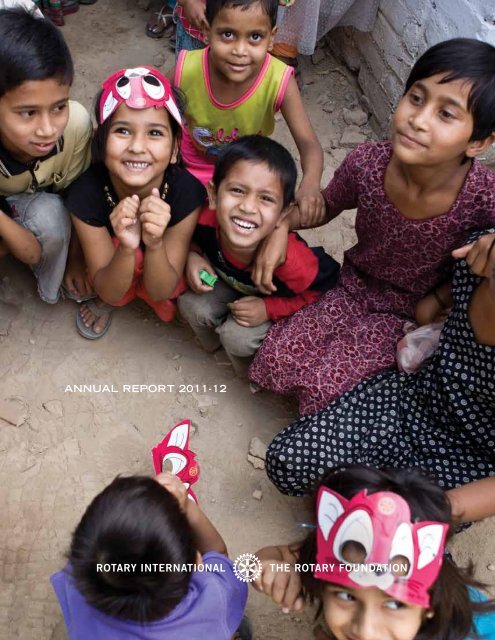
![La présidence du club [222-FR] - Rotary International](https://img.yumpu.com/25855726/1/190x245/la-presidence-du-club-222-fr-rotary-international.jpg?quality=85)
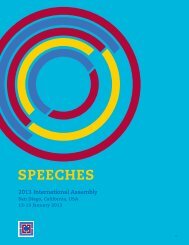
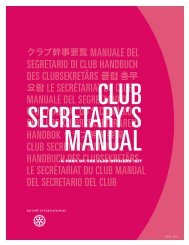

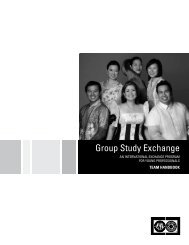
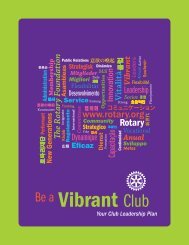

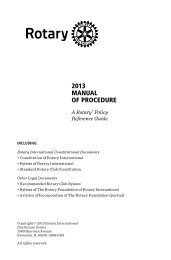

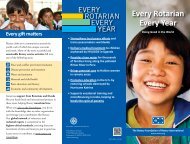
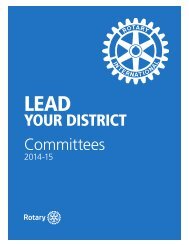

![La conférence de district [800-FR] - Rotary International](https://img.yumpu.com/25855636/1/190x245/la-conference-de-district-800-fr-rotary-international.jpg?quality=85)
